
Beetles are insects that form the order Coleoptera, in the superorder Endopterygota. Their front pair of wings are hardened into wing-cases, elytra, distinguishing them from most other insects. The Coleoptera, with about 400,000 described species, is the largest of all orders, constituting almost 40% of described insects and 25% of all known animal life-forms; new species are discovered frequently, with estimates suggesting that there are between 0.9 and 2.1 million total species. Found in almost every habitat except the sea and the polar regions, they interact with their ecosystems in several ways: beetles often feed on plants and fungi, break down animal and plant debris, and eat other invertebrates. Some species are serious agricultural pests, such as the Colorado potato beetle, while others such as Coccinellidae eat aphids, scale insects, thrips, and other plant-sucking insects that damage crops.
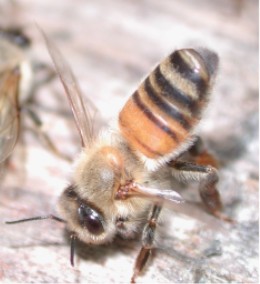
A pheromone is a secreted or excreted chemical factor that triggers a social response in members of the same species. Pheromones are chemicals capable of acting like hormones outside the body of the secreting individual, to affect the behavior of the receiving individuals. There are alarm pheromones, food trail pheromones, sex pheromones, and many others that affect behavior or physiology. Pheromones are used by many organisms, from basic unicellular prokaryotes to complex multicellular eukaryotes. Their use among insects has been particularly well documented. In addition, some vertebrates, plants and ciliates communicate by using pheromones. The ecological functions and evolution of pheromones are a major topic of research in the field of chemical ecology.

Nepetalactone is a name for multiple iridoid analog stereoisomers. Nepetalactones are produced by Nepeta cataria (catnip) and many other plants belonging to the genus Nepeta, in which they protect these plants from herbivorous insects by functioning as insect repellents. They are also produced by many aphids, in which they are sex pheromones. Nepetalactones are cat attractants, and cause the behavioral effects that catnip induces in domestic cats. However, they affect visibly only about two thirds of adult cats. They produce similar behavioral effects in many other felids, especially in lions and jaguars. In 1941, the research group of Samuel M. McElvain was the first to determine the structures of nepetalactones and several related compounds.

The longhorn beetles (Cerambycidae), also known as long-horned or longicorns, are a large family of beetles, with over 35,000 species described. Most species are characterized by extremely long antennae, which are often as long as or longer than the beetle's body. In various members of the family, however, the antennae are quite short and such species can be difficult to distinguish from related beetle families such as the Chrysomelidae. The scientific name of this beetle family goes back to a figure from Greek mythology: after an argument with nymphs, the shepherd Cerambus was transformed into a large beetle with horns.
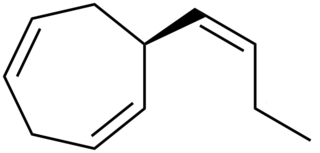
Ectocarpene is a sexual attractant, or pheromone, found with several species of brown algae (Phaeophyceae). The substance has a fruity scent and can be sensed by humans when millions of algae gametes swarm the seawater and the females start emitting the substance to attract the male gametes.
A semiochemical, from the Greek σημεῖον (semeion), meaning "signal", is a chemical substance or mixture released by an organism that affects the behaviors of other individuals. Semiochemical communication can be divided into two broad classes: communication between individuals of the same species (intraspecific) or communication between different species (interspecific).
Sex pheromones are pheromones released by an organism to attract an individual of the same species, encourage them to mate with them, or perform some other function closely related with sexual reproduction. Sex pheromones specifically focus on indicating females for breeding, attracting the opposite sex, and conveying information on species, age, sex and genotype. Non-volatile pheromones, or cuticular contact pheromones, are more closely related to social insects as they are usually detected by direct contact with chemoreceptors on the antennae or feet of insects.

The valley elderberry longhorn beetle is a subspecies of longhorn beetle native to the riparian forests of the Central Valley of California from Redding to Bakersfield. It is listed as a federally threatened species; a proposal to delist the insect was withdrawn in 2014.

A pheromone trap is a type of insect trap that uses pheromones to lure insects. Sex pheromones and aggregating pheromones are the most common types used. A pheromone-impregnated lure, as the red rubber septa in the picture, is encased in a conventional trap such as a bottle trap, Delta trap, water-pan trap, or funnel trap. Pheromone traps are used both to count insect populations by sampling, and to trap pests such as clothes moths to destroy them.
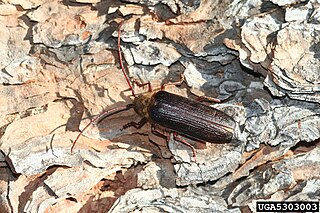
Tragosoma is a genus of beetles in the longhorn beetle family, Cerambycidae.
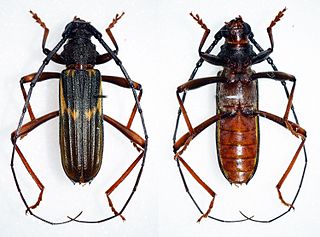
Bothriospilini is a tribe of beetles in the subfamily Cerambycinae. The tribe was proposed in 1950 by Brazilian entomologist Frederico Lane as a member of the new subfamily Bothriospilinae, and with Bothriospila assigned as the type genus. The tribe is morphologically close to the tribe Torneutini, with which it has in common the same shape of the last abdominal segment, which is wide and largely braided in the female, as well as the anterior thigh cavities that are open from behind and the laterally open medial cavity.
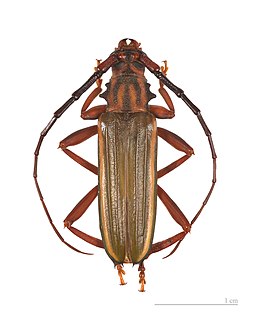
Chlorida is a genus of beetles in the family Cerambycidae, containing the following species:
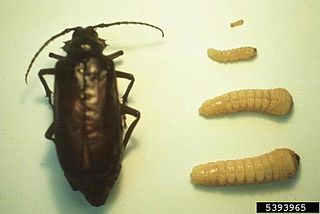
Prionus californicus, commonly known as the California root borer, is a species of insect in the longhorn beetle family (Cerambycidae). It is native to the American west where it is often a pest of orchard and vine crops.

(S)-Ipsdienol is a terpene alcohol. It is one of the major aggregation pheromones of the bark beetle. It was first identified from Ips confusus, in which it is believed to be a principle sex attractant. It is suggested that the compound plays a role in interspecies communication between Ips latidens and Ips ini, facilitating reductions in competition for breeding material and/or mating interference.
Chlorida fasciata is a species of beetle in the family Cerambycidae. It was described by Henry Walter Bates in 1870. It is known to occur in Brazil and Peru.

Chlorida festiva is a species of beetle in the family Cerambycidae. It was described by Carl Linnaeus in his landmark 1758 10th edition of Systema Naturae. It is known from southeastern United States, Central America, South America, and the West Indies. Adult males produce (6E,8Z)-6,8-pentadecadienal, an attractant pheromone. In Puerto Rico the larvae are known to be leaf mining pests of mango crops.
Unaiuba vitticollis is a species of beetle in the family Cerambycidae. It was described by Per Olof Christopher Aurivillius in 1920. It is native to Peru.

Dryobius sexnotatus is a species of beetle in the family Cerambycidae. It is the only species in the monospecific genus Dryobius.

Monochamus galloprovincialis, the pine sawyer beetle, also referred to as the black pine sawyer beetle, is a species of beetle in the family Cerambycidae. It was described by Olivier in 1795, originally under the genus Cerambyx. It has a wide distribution, occurring naturally throughout Europe and the Caucasus. It has also been introduced into the Canary Islands. It serves as a vector for the parasitic nematode species Bursaphelenchus xylophilus, and also acts as a host to the parasitoid wasp species Dolichomitus tuberculatus.
Various tetradecadienyl acetate compounds serve as insect mating pheromones especially among the Pyralidae. These include:












